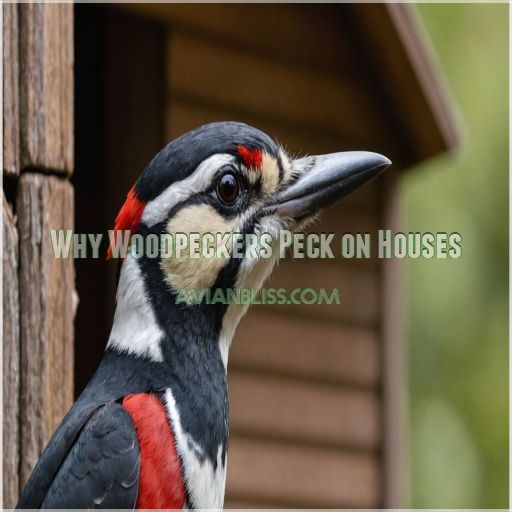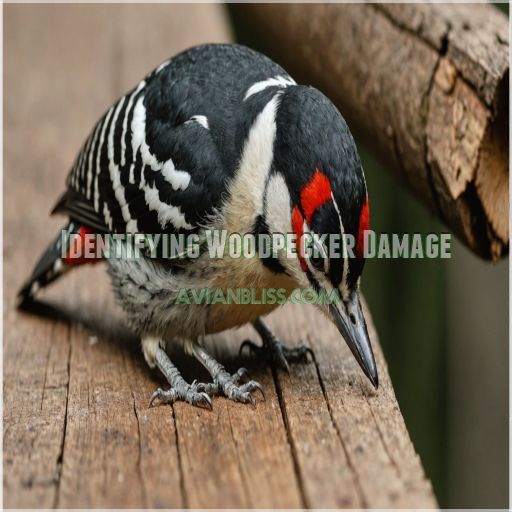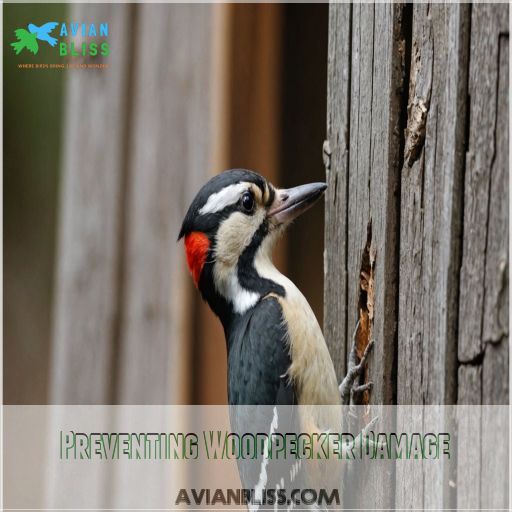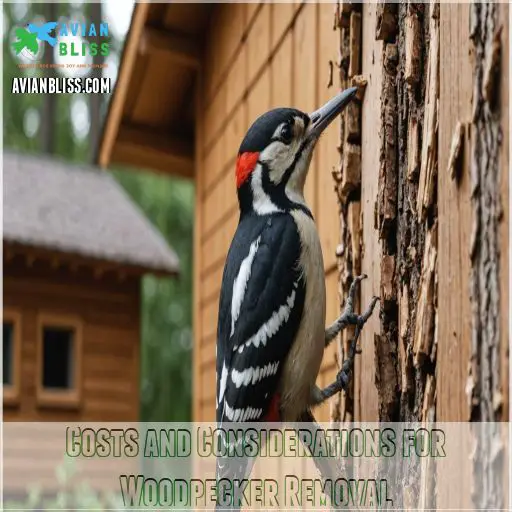This site is supported by our readers. We may earn a commission, at no cost to you, if you purchase through links.
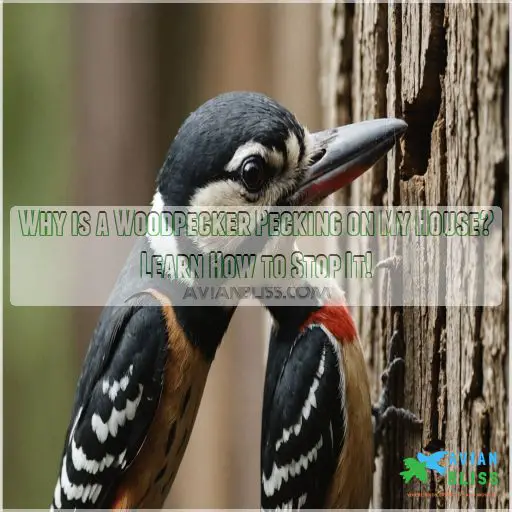
They could be nibbling away searching for tasty insects like termites hiding within your walls.
Your home’s siding and color play their part too—earthy tones and grooved plywood are like a personal invitation to peck! And let’s not forget, sometimes they’re just looking for a cozy nesting site.
To keep your house woodpecker-free, explore clever deterrents and create a harmonious environment they’ll peck elsewhere. Curious about these smart strategies? Read on!
Table Of Contents
- Key Takeaways
- What Attracts Woodpeckers to Houses
- Why Woodpeckers Peck on Houses
- Identifying Woodpecker Damage
- Preventing Woodpecker Damage
- Deterrent Methods for Woodpeckers
- Providing Alternative Food and Nesting Sites
- Repairing Woodpecker Damage to Siding
- Costs and Considerations for Woodpecker Removal
- Woodpecker Behavior and Control
- When to Call a Professional for Help
- Frequently Asked Questions (FAQs)
- What does it mean when a woodpecker pecks at your house?
- How do you get a woodpecker to stop pecking on your house?
- Is woodpecker pecking seasonal or year-round?
- Can woodpeckers cause structural damage?
- Are woodpeckers attracted to specific house colors?
- Do woodpeckers target new or old houses?
- How long does woodpecker nesting last?
- Conclusion
Key Takeaways
- Drumming Up Drama: Woodpeckers aren’t auditioning for a rock band on your house; they’re marking territory or seeking a mate with their rhythmic tapping. During mating season, they’re nature’s percussionists, letting everyone know who’s the boss.
- Calling All Bug Buffets: Your home might secretly host a bug banquet. Woodpeckers have a knack for finding termites and other insects hiding in your siding, treating it like their personal all-you-can-eat diner.
- Color and Comfort Matters: Houses sporting earthy tones and grooved plywood might as well hang a "Peck Here" sign. These natural hues and textures attract woodpeckers, so consider a brighter paint job to make your home less appealing.
- Deterrence and Diversions: Keeping woodpeckers out of your hair involves playing defense. Motion-activated sprinklers, shiny objects, and suet feeders can redirect their attention, so you can reclaim your peace and quiet without going cuckoo.
What Attracts Woodpeckers to Houses
Ever wondered why woodpeckers are constantly pecking at your house?
Usually, these industrious birds are asserting their territory, locating a tasty insect buffet hidden in your walls, or they’re just chafing because your siding color isn’t up to their avian standards!
Territory and Mating Behavior
Imagine a woodpecker rock concert! During mating season, woodpeckers engage in vigorous drumming patterns to establish territory and attract mates.
- Loud Drumming: Spring activity picks up.
- Territorial Displays: Nest site selection is important.
- Mating Rituals: Expect temporary woodpecker damage.
Food Sources and Insect Infestations
When woodpeckers tap-tap-tap on your house, they’re often chasing a buffet of bugs. They’re nature’s inspectors, detecting carpenter bees, termites, and other creepy crawlies. Protect your peace by knowing these pests:
| Pest | Common Signs | Control Methods |
|---|---|---|
| Termites | Mud tubes, wood rot | Termite control |
| Carpenter Bees | Round holes, sawdust | Insect identification |
| Ants | Visible trails | Regular inspection |
| Spiders | Web clusters | Wildlife control |
Knowing these pests can help you identify and control them before they cause major damage to your home.
Siding Type and Color Attraction
Certain siding types and house colors are more appealing to woodpeckers.
Grooved plywood and earth-tone stained houses are prime targets, as the birds are drawn to these surfaces for nesting and foraging.
Choosing bird-resistant siding and brighter paint colors can help deter unwanted pecking.
Why Woodpeckers Peck on Houses
When a woodpecker turns your house into a concert hall, it’s usually announcing its search for a mate or staking its territorial claim.
Sometimes, it’s just looking for a tasty insect snack or a new spot to call home, so don’t take it personally!
Drumming for Mates and Territory
Imagine this: a woodpecker turned percussionist, drumming on your house like it’s auditioning for a bird band.
This rhythmic tapping helps establish territorial boundaries and attract mates during the mating season.
These woodpecker mating rituals tell friends to keep out and partners, "Come closer.
Creating Nests and Roosting Sites
While woodpeckers might drum for love, they also target your house for cozy nesting spots.
Seek expert help to navigate the woodpecker’s nesting fascination:
- Protect siding with bird netting to prevent direct access
- Avoid sticky repellents
- Use aluminum foil
- Reflective tape near potential roosting sites
Foraging for Insects and Food Storage
Your home may be a prime target for hungry woodpeckers seeking insects like termites, ants, or even acorns to store.
By identifying and eliminating these food sources, you can discourage their pecking and protect your siding.
Skedaddle Wildlife Control can help assess and address any underlying infestations.
Identifying Woodpecker Damage
When a woodpecker turns your house into its own personal construction site, it’s time to crack the case of mysterious holes and siding damage.
Understanding why your home has become a pecking target will help you uncover whether it’s a love-struck bachelor drumming for a mate or just hunting for a buggy buffet.
Types of Holes and Their Meanings
Spotting woodpecker holes might feel like detective work.
Notice the hole size and shape: single large ones indicate a nesting site, while small, irregular patterns suggest insect foraging.
Location matters too; they can’t resist prime real estate near delicious bug-filled nooks!
Now, what’s your woodpecker strategy?
Siding Damage and Statistics
Siding damage from woodpeckers mightn’t leave you feeling chirpy.
Grooved plywood is a frequent victim compared to other siding types.
Earth-tone stains? They’re like a red carpet for these birds.
If you’re worried about repair costs, prevention tips can save your nest—and sanity—before it’s too late!
Recognizing Pecking Patterns and Behavior
Recognizing woodpecker pecking patterns is key – a single large hole likely signals a nest, while multiple small, irregular holes suggest foraging for insects.
Pay close attention to the intensity and rhythm of their drumming; it may reveal their true motives.
Preventing Woodpecker Damage
If a woodpecker’s using your house as its personal drum, it might be time for some preventive measures to shoo them away.
You’ll need to tackle pesky insects hiding in your siding and plug up any pecking spots like you’re closing a fast-food joint before the dinner rush.
Eliminating Food Sources and Insect Infestations
Before fixing woodpecker damage, you should eliminate their food sources. Insect infestations in your home can be like an open buffet for them.
To prevent this:
- Inspect siding.
- DIY pest control techniques like using natural repellents can be effective in deterring birds from your home.
- Practice termite prevention.
- Focus on carpenter bee control.
Sealing Holes and Detering Nesting Sites
Let’s fill and seal those pesky holes to deter woodpecker nests. Use wood putty for small holes and consider siding choices like bird-safe materials for more extensive repairs.
It’s a DIY repair solution that keeps birdhouses away, ensuring your home stays safe and sound from nesting invaders.
| Task | Solution | Benefit |
|---|---|---|
| Fill Small Holes | Wood Putty | Discourages Nesting |
| Extensive Repairs | Replace with Vinyl | Less Attractive to Birds |
| Cover Entry Points | Aluminum Flashing | Stops Further Excavation |
| Scare Tactics | Use Reflective Tape | Deters Curious Birds |
| Secure Open Gaps | Secure Bird Netting | Prevents Bird Access |
Using Motion-Activated Sprinklers and Shiny Objects
If motion-activated sprinklers don’t scare off the persistent woodpecker, try hanging shiny objects around your home. These can include mirrors, Mylar balloons, or reflective streamers – the movement and glare will deter the bird from returning. Just be sure to move them regularly to maintain their effectiveness.
- Reflective streamers
- Mylar balloons
- Mirrors
- Aluminum foil
- Windsocks
Deterrent Methods for Woodpeckers
Woodpeckers wreaking havoc on your house?
Let’s explore simple ways to shoo them off,
from waving shiny streamers
to employing noisy gadgets that make them think twice about turning your siding into Swiss cheese.
Reflective Streamers and Plastic Owls
Reflective streamers can work wonders in deterring woodpeckers, making your home less appealing as an all-you-can-peck buffet.
While plastic owls might temporarily spook them, woodpeckers prove quite cunning, soon adapting.
Make sure streamer placement is strategic, enhancing effectiveness and leaving birds guessing like a decoy detective story.
Distress Calls and Noise-Making Devices
Distress calls can ruffle woodpecker feathers when used alongside noise-making devices. However, these deterrents often lose effectiveness over time.
Consider their drawbacks:
- Woodpeckers grow accustomed to repeated sounds.
- Nearby neighbors might not appreciate the racket.
- Regulations may limit noise levels in your area.
Alternative Deterrents and Repellents
Hang wind chimes, pinwheels, or mylar balloons to scare off woodpeckers with their shiny, fluttering movements.
Burlap and bird netting can also block access to your home.
These natural deterrents are a budget-friendly way to outsmart those persistent peckers.
Providing Alternative Food and Nesting Sites
If you’ve ever felt like your home has become a woodpecker’s favorite snack bar, providing alternative food and nesting sites can redirect their attention.
Set up suet feeders and roost boxes to give these persistent peckers a new hangout spot away from your house.
Suet Feeders and Roost Boxes
Consider setting up suet feeders away from your home to offer woodpeckers an appealing alternative. They love suet, and placing a roost box at your property’s edge gives them a cozy nesting spot.
Try making your own DIY suet feeders, but make sure bird feeder safety against critters!
Installing Bird-Friendly Features
Transform your yard into a haven for woodpeckers by adding bird-friendly features.
Install roost boxes and suet feeders, ensuring ample food and shelter.
Enhance your landscaping with native plants and bird baths to create an inviting space.
Remember, the ringmaster controls the circus, not the crowd!
Creating a Woodpecker-Friendly Environment
Crafting a woodpecker-friendly backyard is a hoot!
Offer a hearty suet feast to satisfy their insect cravings.
Erect cozy roost boxes for their nesting needs.
Native trees and shrubs provide shelter and attract their favorite bugs.
With a few simple tweaks, your yard can become a woodpecker wonderland!
Repairing Woodpecker Damage to Siding
When woodpeckers treat your house like their own personal drum set, it’s time to think about repairs.
You can fill those unsightly holes with epoxy putty, or consider upgrading to siding that’s a little less "woodpecker-friendly.
Filling Holes With Epoxy Putty
To patch those pesky holes left by woodpeckers, apply epoxy putty. It’s a bit like giving your house a quick facelift!
Depending on hole size, smooth it over and let it dry—just remember, time is key.
Its durability stands strong, unlike short-lived alternatives. Happy repairing!
Replacing Old Siding With Bird-Resistant Materials
Switching to bird-resistant siding options like vinyl or aluminum can save you from woodpecker woes.
Vinyl’s durable, while aluminum’s as tough as nails.
Before you make a decision, weigh the cost comparison and consider installation tips.
Remember, going DIY or hiring pros affects both your time and wallet!
Hiring a Professional for Extensive Damage
If woodpecker damage has really taken a toll on your siding, it’s best to call in the pros.
They’ll expertly assess the situation, handle the repairs, and make sure everything’s up to snuff – all while keeping wildlife regulations in mind.
No need to DIY this one!
Costs and Considerations for Woodpecker Removal
Dealing with woodpecker damage can be a real "peck-on-the-head" moment, especially when considering whether to tackle the problem yourself or bring in a pro.
We’ll explore the costs, from patching up those pesky holes to hiring someone who knows their peck from their perforation.
DIY Vs. Hiring a Professional
Deciding between DIY and hiring a professional to tackle woodpecker woes? Consider these points:
- Cost Comparison: DIY might save dollars, but professionals offer value.
- Effectiveness: Pros deliver results.
- Peace of Mind: Relax, let them handle it.
- Legal Concerns: Navigate wildlife laws carefully.
- Safety Risks: Climbing ladders is tricky business!
Cost of Bird Nest Removal and Repair
When it rains, it pours, right? Well, woodpecker damage can certainly dampen your day. Removing a bird nest and repairing related damage could cost between $450 to $600.
Consider DIY vs. pro options.
Check if insurance covers labor, material costs, and any required permit fees.
Factors Affecting Removal and Repair Costs
The cost of woodpecker removal and siding repair can vary widely, depending on the severity of the damage, the type of siding, and whether you tackle it yourself or hire a professional.
Factors like labor, materials, and any necessary pest control treatments can all impact the final bill.
- Siding type and condition
- Extent of damage to repair
- DIY vs. professional services
Woodpecker Behavior and Control
Woodpeckers might see your home as a perfect spot to hammer away, but don’t worry, they’re just the clever engineers of the bird world.
Let’s explore why these feathery critters are drumming on your house and how you can humanely guide them elsewhere, as their antics are more about survival than spite!
Understanding Woodpecker Intelligence and Adaptation
Curiosity is key when understanding woodpecker smarts.
Sharp memory and playful learning help these birds adapt quickly.
Check out the table:
| Feature | Detail | Example |
|---|---|---|
| Problem-Solving | Innovative pecking tactics | Avoid static objects |
| Communication | Drumming sends messages | "Stay away" alerts |
| Tool Use | Use if needed, rarely seen | Crafty twig pick-ups |
These intelligent creatures keep you on your toes!
Non-Lethal Methods for Woodpecker Removal
Got a woodpecker drumming like it’s in a rock band? Consider humane options.
Decorative spirals and wind chimes can deter nicely, while motion-activated sprinklers give surprise showers.
These DIY solutions keep your home bird-friendly, ensuring harmony without turning your place into their favorite concert stage.
Adhering to Local Wildlife Regulations
Woodpeckers are protected by federal and state laws, so you can’t just shoo them away. You’ll need to get the right permits and use humane traps if they’ve nested on your property. The fines for disturbing their homes aren’t worth it, so play by the rules.
- Check your local wildlife regulations
- Obtain necessary permits before removal
- Use only approved, humane trapping methods
- Avoid harming protected bird species
- Consult a professional wildlife expert
When to Call a Professional for Help
If your house has become a woodpecker’s favorite playground and you’re noticing holes and damage, it might be time to call in the pros.
DIY solutions often fall flat, leaving you with more headaches and a woodpecker that thinks it’s found a permanent gig.
Signs of Significant Damage or Infestation
Recognize significant woodpecker damage by checking the siding type, hole size, and any lurking insect types.
If your house looks like Swiss cheese, it’s time to call a professional.
Sometimes, a hole isn’t just a hole but a buffet.
Here’s a handy guide:
| Damage Sign | What to Check | Why It Matters |
|---|---|---|
| Multiple Holes | Siding Type | More vulnerable types |
| Large Holes | Hole Size | Potential nest sites |
| Insect Droppings | Insect Type | Attracts woodpeckers |
Risks of DIY Removal and Repair
If you’re worried about woodpecker damage, DIY fixes might seem appealing. But let’s think through potential pitfalls:
- Safety hazards when climbing ladders.
- Legal issues if you disturb nests.
- Ineffective solutions that invite further pecking.
- Risk of injury to yourself or wildlife.
- Unseen structural damage worsening over time.
Benefits of Hiring a Professional for Woodpecker Removal
While tackling woodpecker problems yourself may seem tempting, calling in the experts is your best bet. They have the know-how and tools to handle these feisty birds safely and effectively, ensuring your home stays protected without harming the wildlife.
Take a look at the benefits:
| Benefit | Description |
|---|---|
| Expertise | Professionals understand woodpecker behavior and use humane removal methods to prevent woodpecker damage. |
| Safety | They follow local regulations to protect you and the birds. |
| Prevention | Experts can identify and address the root causes, stopping future damage. |
| Peace of Mind | Let the pros handle it so you can relax, knowing your home is in good hands. |
Experts offer a range of benefits, including expertise, safety, prevention, and peace of mind.
Frequently Asked Questions (FAQs)
What does it mean when a woodpecker pecks at your house?
When a woodpecker pecks your house, it might be establishing territory, attracting mates with loud drumming, or hunting insects.
This natural orchestra sometimes leads them to your siding, especially if it’s grooved plywood or earth-toned.
How do you get a woodpecker to stop pecking on your house?
Banish those pecking pests with a sprinkle of motion-activated magic!
Install a smart sprinkler system to startle woodpeckers and reclaim your home’s peace.
Pair it with shiny deterrents for a one-two punch against those persistent peckers.
Is woodpecker pecking seasonal or year-round?
Woodpecker pecking isn’t just a seasonal game; it’s a year-round endeavor.
Whether they’re claiming territory or hunting for bugs, they find reasons to peck regardless of the season, though some specific activities peak around breeding times (Source).
Can woodpeckers cause structural damage?
Yes, woodpeckers can cause structural damage to your home by creating holes for nesting, storing food, or hunting insects.
These actions weaken the siding, inviting pests and moisture, compromising your home’s integrity.
Are woodpeckers attracted to specific house colors?
Consider this: Buildings painted earth-tone are like "all-you-can-peck" diners for woodpeckers.
They’re more likely to hammer away at these natural hues.
Go brighter and you’ll rarely hear that infamous tap-tap-tap echoing through the walls.
Do woodpeckers target new or old houses?
You’d be surprised – woodpeckers don’t discriminate between new and old houses.
They’re drawn to the type of siding and color, not the age of your home.
Addressing any insect infestations is key to deterring their pecking.
How long does woodpecker nesting last?
Imagine a woodpecker with a calendar; nesting usually kicks off in late April or May and lasts throughout the breeding season, which is spring to mid-summer.
By then, they’re out hunting for bugs again!
Conclusion
Understanding why a woodpecker is pecking on your house, grasping their behavior, and applying effective deterrents is key to peace and quiet.
Identifying feeding sites, sealing potential nests, and offering alternatives are all important steps in protecting your home and creating a wi-fi for wildlife harmony.
Think of it as peaceful peck-proofing! Whether it’s shimmer, noise, or suet, you’ve got the tools to redirect their stubborn persistence elsewhere and secure your siding once and for all.


